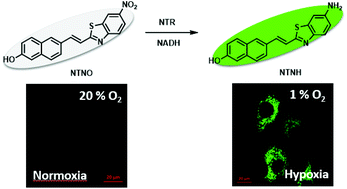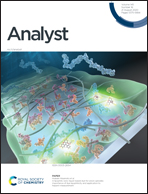Hypoxia imaging in living cells, tissues and zebrafish with a nitroreductase-specific fluorescent probe†
Abstract
Hypoxia in solid tumors is directly linked to the elevated levels of endogenous nitroreductase (NTR). We present a novel fluorescent probe, namely NTNO, for nitroreductase-specific detection based on the NTR-catalyzed reduction of the nitro unit to an amine functionality, and demonstrated its application for hypoxia imaging. NTNO was designed by incorporating a nitro unit as the NTR response site into a benzothiazole derivative. Upon reacting with NTR in the presence of reduced nicotinamide adenine dinucleotide (NADH), the fluorescence of the probe was strongly and sensitively turned on, with a good linearity in the NTR concentration range of 0.5–8.0 μg mL−1 and a detection limit of 48 ng mL−1. Most notably, NTNO has been successfully used for imaging hypoxia levels in living cells, tumor tissues and zebrafish, making it of great potential to monitor NTR in biological systems.



 Please wait while we load your content...
Please wait while we load your content...